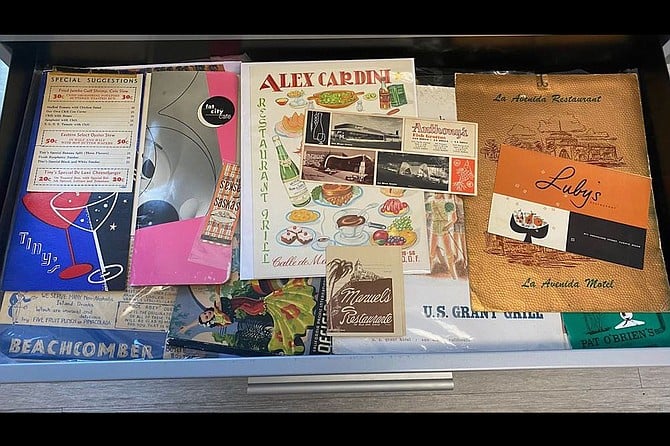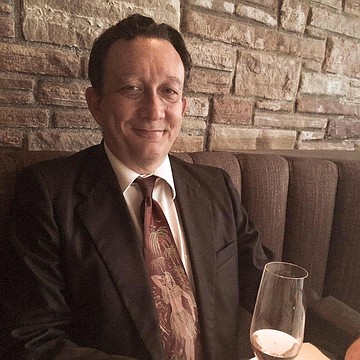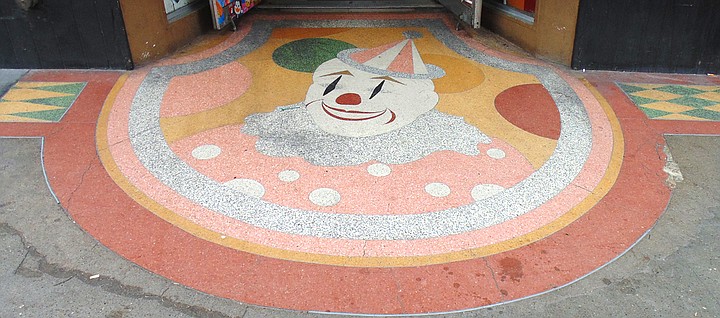 Facebook
Facebook
 X
X
 Instagram
Instagram
 TikTok
TikTok
 Youtube
Youtube

If you happened to be on the internet looking for the “oldest restaurant in San Diego,” or wanted to find some information about, say, “Lubach’s Restaurant”, defunct since 1990, those queries would have led you to Martin Lindsay’s Classic San Diego website. He’s the first hit for those two, and among the first for many more queries related to historic food, drink, and hospitality in America’s Finest City. From the homepage, you can click through to a general section (Restaurants), or to Lindsay’s more specialized material: Mexican, Oldest, Tiki.

Lindsay, a graphic designer and San Diegan since 1969, started his site around 2015 as a way to showcase some of the historical digging he had been doing since getting particularly interested in old restaurants and bars. He had started looking at old menus and matchbooks while engaged in design work for restaurants, and something about it just captured him and led him to investigate the details and stories of the places from which they hailed. He likes the way that restaurants are multidimensional: they give us a picture of peoples’ social lives, of history, and of cultural exchange. Restaurants are about the creation of a special environment, something that the old Chinese palaces and Mexican cantinas that Lindsay writes about worked hard to create.
It occurred to him that “this is a great way to tell the history of San Diego. Not through just the architecture, not through historical facts, but through the businesses and the experiences all these people have had.”


Maybe part of his interest came from seeing the city change so much from his boyhood to the present day, or the fact that his parents were older than was typical in his generation, so that the good old days he grew up hearing about connected him to a more distant past. But I told Lindsay that it seems to me that nostalgia is often just something some people have; an inborn affection for the past just befalls them. “That’s me totally,” he says, even as he argues that nostalgia is not actually among the first reasons Lindsay gives for why he pursues his interests in Classic San Diego. I expect him to say something about it when I ask him what he finds appealing about the past generally, but his first answer is “the lack of information.” He says that there is a lot that hasn’t been written about in the way that he wants to know about it. “I like the digging. I like the research”, he tells me.
Still, I wonder if it’s hard for him, being that kind of a vintage-loving outlier in a city that is not especially known for a concern with its own history or the material preservation of its past. Lindsay gives me less rancor than I expected here. We talk about the time that some development plan wanted to tear down Old Town, and how Chinatown was torn down, and about the mid-century push to make San Diego a center for industry and innovation — smokestacks winning over geraniums, as a 1917 political campaign in San Diego once put the dichotomy. Our conversation only occasionally touches on closed restaurants, bars, and hotels. He’s attuned to the loss involved when he holds forth on these and other topics , but he’s also attached to this place and likes living here. Even if there have been too many times that the tasteless greed of city fathers and developers has conquered sections of the City Beautiful, it’s hard for him to imagine going somewhere else.
One day, Lindsay was busy at the San Diego History Center when an elderly employee of the institution, circulating around to see what people were working on, asked him what he was doing. He told her that he was “researching the history of San Diego restaurants.”
“Oh. I haven’t seen anyone doing that before,” she said. “That’s new. I like that.” He said it helped him to feel like he was on to something.
“I guess it would strike people as a very niche interest,” I say.
“It is,” he agrees, “but we can all relate.” Because nearly everyone has been to a restaurant, and many probably have some memories of old ones, or of places their parents liked to go, there is a certain amount of popular appeal.
Some of Lindsay’s discoveries have happened not in libraries, but on the street. He tells me a story about the time on Fourth Avenue that the sighting of a circus-themed building facade and some old doorway terrazzos of a clown and a palm tree led him to eventually figure out that he was standing in front of the old Chi-Chi Club. The place was once a three-in-one establishment, housing a supper club flanked by a circus themed bar as well as a Polynesian bar. More discoveries are sure to come, and Lindsay plans to continue sharing them too.
He is the also author of Ninety Years of Classic San Diego Tiki, 1928-2018, and is currently at work on books about old San Diego restaurants as well as one about Fassionola, a passion-fruit cocktail syrup: “No one really knows it still exists, but it was invented in San Diego in 1916.” He is collaborating on the book with SDSU professor Gregory Pantoja: the book is “specific, very specific, but really fun.”
His next public presentation will be at 10:30 am on May 21st at the Downtown library, where he will be giving a presentation with slides: “Treasures from the Past: Lost Restaurants of San Diego.”


If you happened to be on the internet looking for the “oldest restaurant in San Diego,” or wanted to find some information about, say, “Lubach’s Restaurant”, defunct since 1990, those queries would have led you to Martin Lindsay’s Classic San Diego website. He’s the first hit for those two, and among the first for many more queries related to historic food, drink, and hospitality in America’s Finest City. From the homepage, you can click through to a general section (Restaurants), or to Lindsay’s more specialized material: Mexican, Oldest, Tiki.

Lindsay, a graphic designer and San Diegan since 1969, started his site around 2015 as a way to showcase some of the historical digging he had been doing since getting particularly interested in old restaurants and bars. He had started looking at old menus and matchbooks while engaged in design work for restaurants, and something about it just captured him and led him to investigate the details and stories of the places from which they hailed. He likes the way that restaurants are multidimensional: they give us a picture of peoples’ social lives, of history, and of cultural exchange. Restaurants are about the creation of a special environment, something that the old Chinese palaces and Mexican cantinas that Lindsay writes about worked hard to create.
It occurred to him that “this is a great way to tell the history of San Diego. Not through just the architecture, not through historical facts, but through the businesses and the experiences all these people have had.”


Maybe part of his interest came from seeing the city change so much from his boyhood to the present day, or the fact that his parents were older than was typical in his generation, so that the good old days he grew up hearing about connected him to a more distant past. But I told Lindsay that it seems to me that nostalgia is often just something some people have; an inborn affection for the past just befalls them. “That’s me totally,” he says, even as he argues that nostalgia is not actually among the first reasons Lindsay gives for why he pursues his interests in Classic San Diego. I expect him to say something about it when I ask him what he finds appealing about the past generally, but his first answer is “the lack of information.” He says that there is a lot that hasn’t been written about in the way that he wants to know about it. “I like the digging. I like the research”, he tells me.
Still, I wonder if it’s hard for him, being that kind of a vintage-loving outlier in a city that is not especially known for a concern with its own history or the material preservation of its past. Lindsay gives me less rancor than I expected here. We talk about the time that some development plan wanted to tear down Old Town, and how Chinatown was torn down, and about the mid-century push to make San Diego a center for industry and innovation — smokestacks winning over geraniums, as a 1917 political campaign in San Diego once put the dichotomy. Our conversation only occasionally touches on closed restaurants, bars, and hotels. He’s attuned to the loss involved when he holds forth on these and other topics , but he’s also attached to this place and likes living here. Even if there have been too many times that the tasteless greed of city fathers and developers has conquered sections of the City Beautiful, it’s hard for him to imagine going somewhere else.
One day, Lindsay was busy at the San Diego History Center when an elderly employee of the institution, circulating around to see what people were working on, asked him what he was doing. He told her that he was “researching the history of San Diego restaurants.”
“Oh. I haven’t seen anyone doing that before,” she said. “That’s new. I like that.” He said it helped him to feel like he was on to something.
“I guess it would strike people as a very niche interest,” I say.
“It is,” he agrees, “but we can all relate.” Because nearly everyone has been to a restaurant, and many probably have some memories of old ones, or of places their parents liked to go, there is a certain amount of popular appeal.
Some of Lindsay’s discoveries have happened not in libraries, but on the street. He tells me a story about the time on Fourth Avenue that the sighting of a circus-themed building facade and some old doorway terrazzos of a clown and a palm tree led him to eventually figure out that he was standing in front of the old Chi-Chi Club. The place was once a three-in-one establishment, housing a supper club flanked by a circus themed bar as well as a Polynesian bar. More discoveries are sure to come, and Lindsay plans to continue sharing them too.
He is the also author of Ninety Years of Classic San Diego Tiki, 1928-2018, and is currently at work on books about old San Diego restaurants as well as one about Fassionola, a passion-fruit cocktail syrup: “No one really knows it still exists, but it was invented in San Diego in 1916.” He is collaborating on the book with SDSU professor Gregory Pantoja: the book is “specific, very specific, but really fun.”
His next public presentation will be at 10:30 am on May 21st at the Downtown library, where he will be giving a presentation with slides: “Treasures from the Past: Lost Restaurants of San Diego.”
Comments